Farewell Balkongarten
While so much has changed over the past year, one thing that changed for me in the garden realm was giving up a balcony. In the autumn, my husband and I moved into a new apartment and although we thought we would not give up a balcony, we ended up falling in love with the space and decided to compromise. Luckily, all is not completely lost when it comes to indoor and outdoor growing space in the new place. I can’t wait to share with you the new projects and challenges to come, but in the meantime, let’s review the highlights of the Balkongarten this past year.
Winter
It might seem odd to start with winter, but winter is the preparation for the following growing season. I planted spring bulbs in containers relatively late, in December 2019, a task normally completed in September-November, but time got the better of me during the last months of 2019, to the point where I almost didn’t plant them. I’m so glad I did because they were a sliver of joy for myself during the stressful spring. This winter I’m pushing the boundaries with spring bulbs, having potted up one container in our new place in mid-January 2021 and stowed it away in our new attic space until I can get the next project started: where they will eventually live outside, their new home on the windowsills! (but that’s a later article). If the attic doesn’t get cold enough, there might not be any blooms this year but that’s the fun with experimentation: you won’t know until you try!
A tip for planting bulbs in containers:
Pre-moisten the potting mix before beginning. I was lazy in December 2019 and used a potting mix straight from the bag, then watered from above/soaked from below. The potting mix repelled the water and went straight through the container without much absorption. This is especially common with potting mixes that are compacted with less weight or made with coconut coir. By the end of December I ended up having to unpot the bulbs and agitate the mix with my hand while watering to finally get it to absorb. Save yourself the time and pre-moisten the mix before you begin filling containers.

Header: Balkongarten in March 2020. Here: Crocus bulbs planted in early Dec. 2019.
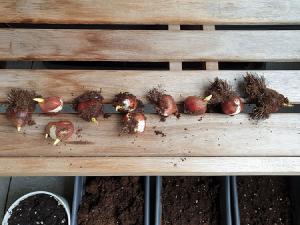
Tulip bulbs with some root formation in late December 2019 when I redid the containers.
A new lesson learned
One major thing I learned over the winter is that if you store dahlia tubers, or Dahlieknollen, they need to be stored below 10ºC (50ºF). Winter 2019-2020 was my first attempt to store tubers, and it was successful…in a way.
I used a cardboard box, placed the tubers inside, filled it with an old, lightly-moistened potting mix, then tucked it away in the building basement. Now, this wasn’t a fully underground basement in American terms but a half underground basement, which helps create what’s called a Hochparterre in German terms. A Hochparterre means the ground-level apartments are not actually located directly on the ground but a half level up since no one wants to live directly at street level for fear of break-ins, though I’d argue the neighborhood watch helps prevent that (I’m looking at you alte Frauen).
For those living outside of Germany here’s a pretty good representation. https://vm.tiktok.com/ZSK5MEv4/
While checking the box’s moisture level in February I found the tubers had sprouted long ghostly stalks, presumably searching for light. This is when I learned that the half-underground basement of the building was not cold enough to keep the tubers dormant over winter.
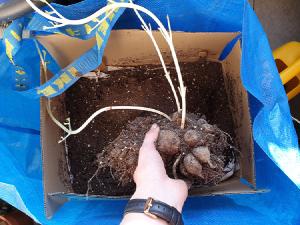
Dahlia tubers in February 2020.
Dahlia tubers should be stored between 4º-10ºC (39º-50ºF). Since I didn’t have access to a cooler spot that was not the freezing temperatures outside, I potted them up in February and placed them next to the windows inside our living room. I had never really appreciated how fast dahlias grow, as they proceeded to take over space in our living room until they were placed outside after the last frost in April. They first bloomed in May; typical bloom time begins in July! It was a good insight into how some commercial growers may manipulate flower bloom times through temperature adjustments. At the end of the year, I might try storing dahlia tubers again in our new attic space, which is significantly chillier than the basement of the previous building.
Spring
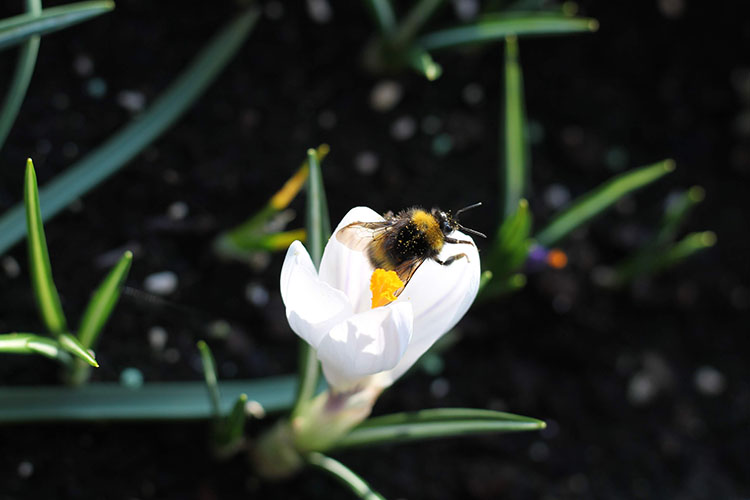
Bumblebee collecting food from a crocus after her winter hibernation.
Warmer weather arrived in March and with it came the first crocus and miniature iris blooms. This was when the WHO declared Covid-19 a pandemic and it was at this time that I really appreciated the Balkongarten. It was the only place where I could take my mind off the current events, watching the crocuses open and close as clouds float by and bumblebees collect nectar from blooms provided some much needed meditation during the chaos.
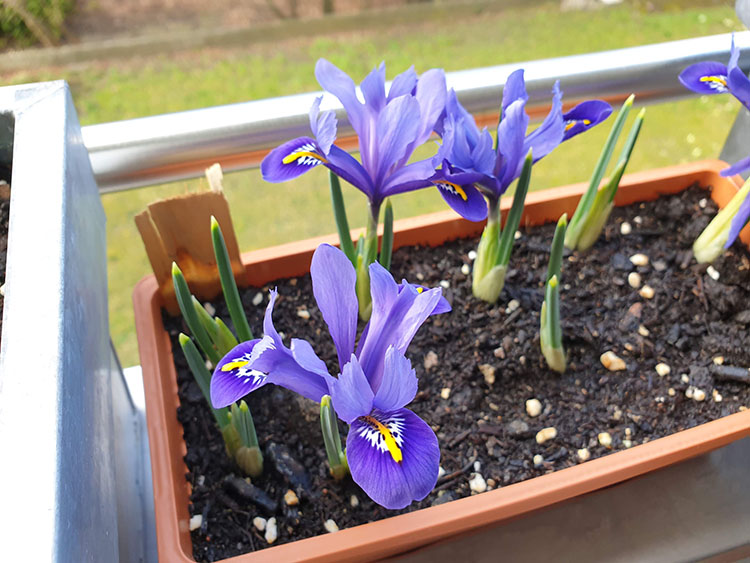
I highly recommend mini irises for spring bulb containers. They require a small amount of space and provide a huge pop of color to the early spring brown monochrome.
April arrived when a different and good kind of chaos brewed, seed sowing! I told myself last season that I would dial back on the balcony, focusing more on herbs and flowers in 2020. As you can tell from the photos below, that went out the window. The borders were closed, meaning there was no access to the Kleingarten just 200m (660ft) over it, and who was I to miss out on growing vegetables that season? And, as a fellow plant lover on Instagram commented, “who needs to sit anyway?” It turned out to be a fun experience, learning how to grow a few new vegetables in containers even if they didn’t turn out perfectly, but more on that later.
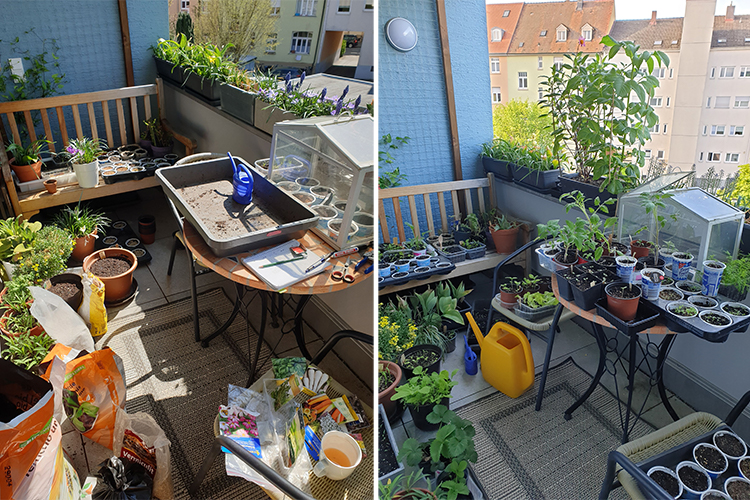
The beautiful chaos of spring seed sowing
Two new vegetables on the balcony were peas and beans. Being stuck at home meant more time to figure out how to fit more plants on the balcony. I pictured the side wall would turn into a Naschgärtchen with lush green vines of vegetables to snack on, and while it was a minor success with a few peas and beans to harvest, unfortunately the Balkongarten did not receive enough full sunlight in this area throughout the day. Despite it facing south, the ceiling blocked some hours of potential sunlight, and only plants on the ledge received a full day’s worth of sun. I had trouble getting the pea and bean seeds to sprout because the container stayed too cool. Makeshift cloches helped a little but it would have been better to set the boxes on the sunny ledge until the seeds germinated. I’m still happy with the experiment and what didn’t work for me might work for you, so here’s a quick breakdown of what I did:
Naschgärtchen Projekt
I used some old ribbon yarn for the structure, tied some knots across the top horizontal strip to hold the vertical strands in place then wrapped the vertical strands around one of the wood planks on the bench to anchor it. I would recommend using a stronger string or rope in case you have better luck than I did to hold the weight of the plants. The potential load-bearing limit didn’t come to mind until after everything was hung up, though fortunately/unfortunately I didn’t grow enough plant mass for it to become an issue.
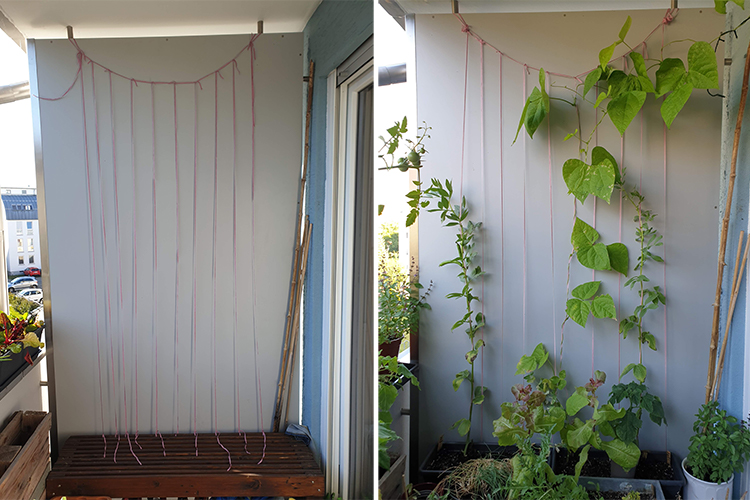
Pea and bean wall in April and July
By mid-April the tulips, anemones and grape hyacinths were at their peak and buzzing with activity from various bee species.
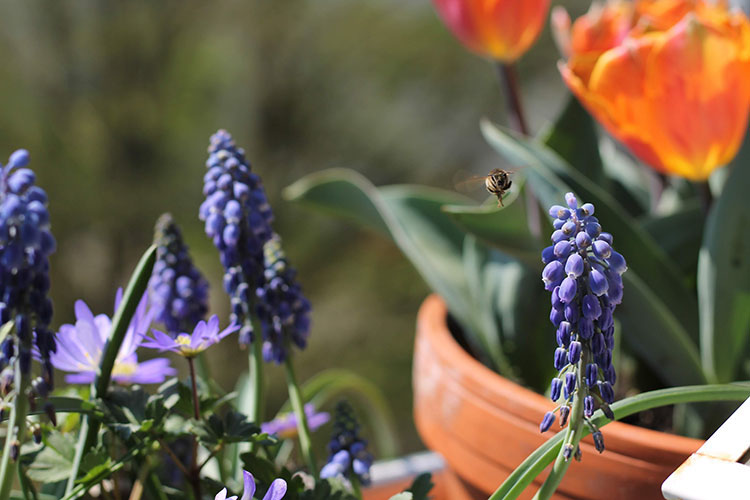
Can you spot the honeybee hopping between grape hyacinths?
Another experiment was a few polyculture pots. I created one container with carrot and lettuce seed and another container with parsnip and spinach seed. I used the lettuce and spinach as mini greens while waiting on the carrots and parsnip seeds to germinate. It would have been best to thin out the lettuce and spinach to just 2-3 plants instead of 10 for the size of pots that I used (or, you know, use larger pots), but overall I was happy and harvested a few carrots and parsnips by the end of summer.
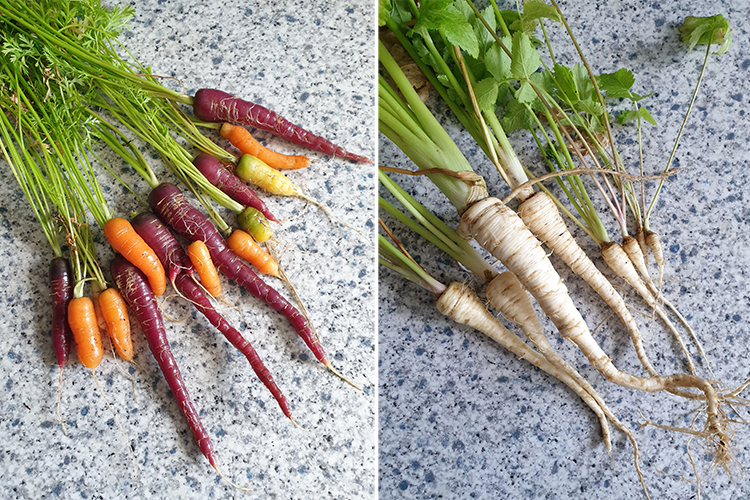
Carrot and Parsnip harvest in September, small but still delicious. The roots might have bulked up had I been more on top of watering throughout the season.
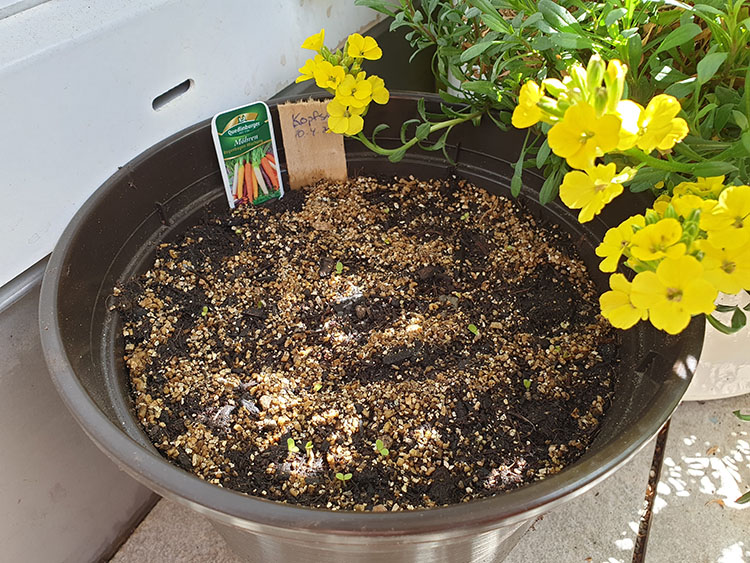
Carrot and lettuce polyculture container.
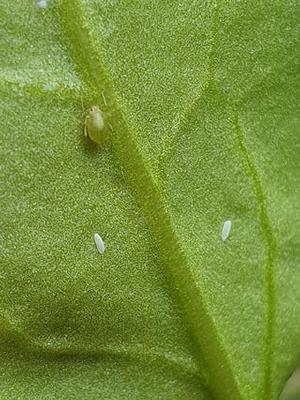
Two white leafminer eggs with a green aphid for size comparison.
A New Pest
Growing the spinach in cramped, less-than-ideal conditions attracted a new unfamiliar pest: leafminers. They can be found burrowing between the upper and lower leaf epidermis of leaves. Luckily, they are easy to spot in the leaf during the larva stage and can easily be cut out, but the damage will have already been done. To spot the problem beforehand, check the underside of leaves for tiny white eggs and gently scrape them off with your fingernail to crush them with your fingers.
As you can tell from the above photo I also had a familiar foe: aphids. I resisted the urge to use neem oil to attract the familiar ladybug predator which paid off because I also attracted the less familiar hoverfly and parasitic wasp predators. As much as I don’t want to watch my plants grow weak from pests, I really do enjoy watching aphid predators, which is why I tolerate the aphids. I mean, you’ve got to admit watching this hoverfly larvae eat an aphid is pretty cool, and so is watching the parasitic wasp hunt for aphids.
I also really enjoy the adult hoverfly behavior, swaying from left to right in a sharp zig-zag manner, sometimes abruptly hovering for several seconds to inspect whether I was a friend or foe, as they searched for plants to lay eggs. The hoverflies most likely wouldn’t have arrived if it weren’t for the shallow-faced flowers of wild carrot, dill, and alyssum on the balcony, so if you wish to attract these curious little flyers be sure to have one of these flowers around as a nectar source for the adults.
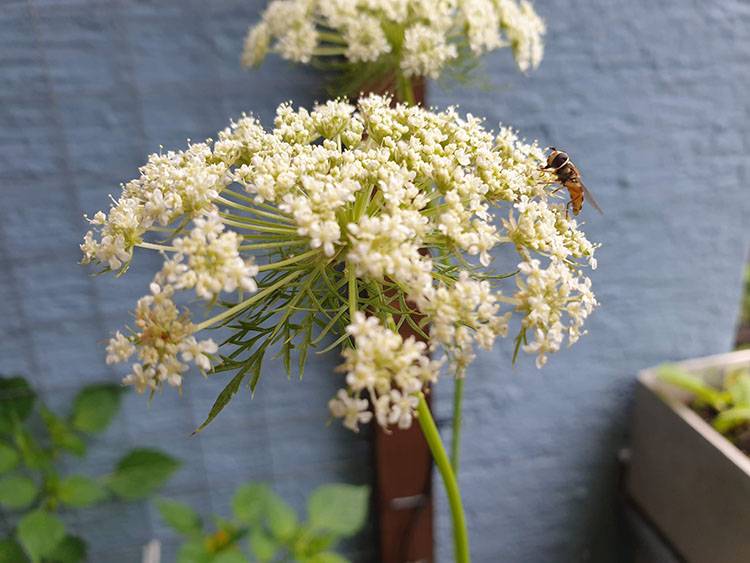
An adult hoverfly sipping nectar from a wild carrot Daucus carota flower.
Summer
By June I hung some lights and planted a few brightly-colored flowers to add some festivity to the space. The flowers attracted more pollinators to watch during the day, while the lights gave the warm evenings of sipping wine a nice glow.
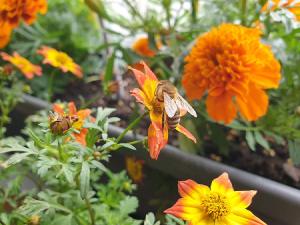
Honeybee on Goldmarie ‘Beedance’ Bidens ferulifolia.

Enjoying the night peering through the tomato plants as June’s full moon rises.
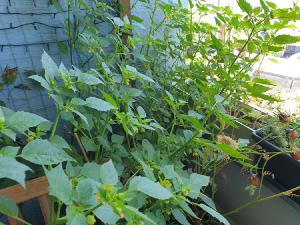
Enjoying the night peering through the tomato plants as June’s full moon rises.
August arrived when many plants were looking less than stellar from the summer heat but I didn’t mind because it was still a place of refuge. If we were still living there I would try setting up an irrigation system. As I’ve stated in a past post, my least-favorite garden activity is watering, and though I watered at least twice a day it didn’t seem to be enough. I think the plants in this space would have prefered a slow, steady drip for 1-2 hours twice a day for a more even distribution of moisture throughout the day.
One of the few plants that loved the heat was the tomatillo. It was huge! I got a lot of flowers but not many tomatillos themselves, though that was due to laziness of not collecting pollen from a friend’s tomatillo plant. Tomatillos are not good self-pollinators and require at least one other plant for cross pollinating. On my plant with more than 100 flowers and I received maybe 10 small tomatillos. They are very large, prolific plants so I do not recommend growing them on a small balcony, and since they do grow large they will require support. In the sheltered corner of the balcony I tied the main stem to a wire trellis. If you have a large balcony, and one that is large enough for two plants, then definitely give them a try.
Autumn
Autumn arrived and it was time to pack the apartment, harvest the last summer tomatoes, and clean the balcony. We were ready to move but it was bittersweet leaving the balcony behind. I learned a lot about container gardening in this space and still have a lot more to learn about it. Thankfully, I can continue to learn in the new apartment though it will be a little different, but I’ll get to that in a future post. We still live near the Kleingarten so there will still be plenty to learn and do there but until then I say farewell, Balkongarten, you were a great teacher.

Farewell, Balkongarten


